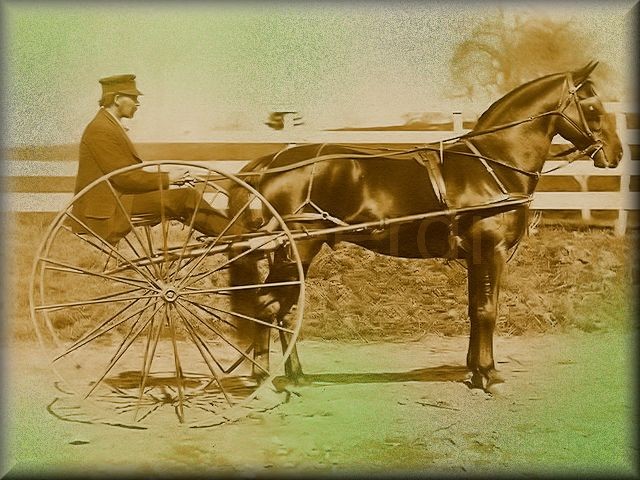sulky / sulky plow

A two-wheeled carriage for a single person, so called from the owner’s desire of riding alone. — Webster, 1882
 There was a trial of the draught of the Hapgood sulky and walking plows last Saturday on the farm of Mr. Wilder. The result was as follows; Sulky plow, 16 inch, depth 5.6 inches, draught 377 ½ pounds. Walking plow, 14 inches, depth 5.5 inches, draught 397 pounds. – The De Smet Leader, 1883.
There was a trial of the draught of the Hapgood sulky and walking plows last Saturday on the farm of Mr. Wilder. The result was as follows; Sulky plow, 16 inch, depth 5.6 inches, draught 377 ½ pounds. Walking plow, 14 inches, depth 5.5 inches, draught 397 pounds. – The De Smet Leader, 1883.
 A sulky is a one-seated two-wheeled conveyance; two different sulkies are mentioned in the Little House books. In Farmer Boy, one of the events viewed by Almanzo Wilder and his father is the race of trotting-horses pulling a sulky with single driver. In the 1850s, trotting-horse races were a major event at agricultural fairs, such as the Franklin County Fair in Malone, with New York being the major producer of trotting horses. [— Phillip Thurtle, The Emergence of Genetic Rationality (Seattle: University of Washington Press, 2007), 38-40.
A sulky is a one-seated two-wheeled conveyance; two different sulkies are mentioned in the Little House books. In Farmer Boy, one of the events viewed by Almanzo Wilder and his father is the race of trotting-horses pulling a sulky with single driver. In the 1850s, trotting-horse races were a major event at agricultural fairs, such as the Franklin County Fair in Malone, with New York being the major producer of trotting horses. [— Phillip Thurtle, The Emergence of Genetic Rationality (Seattle: University of Washington Press, 2007), 38-40.
An advertisement in The Malone Palladium in September 1867 mentions the trotting races:
Franklin County Fair. The officers of the Franklin County Agricultural Society are completing the necessary arrangements for the Fair to be held here next week, and expect, with good reason, we think, that it will be a more complete success than any of the Fairs heretofore held by the Society. The premiums offered are liberal, and if our farmers and mechanics take hold of the matter with as much interest as they should, there is no reason why the expectations of the officers of the Society will not be fully realized. We understand that Hon. L.J. Bigelow, of Watertown, has been engaged to deliver the Annual Address, which will take place on Thursday afternoon, at one o’clock. The services of the Malone Cornet Band have been engaged through the Fair, which, together with the liberal purses offered for trotting, cannot fail to make the exhibition attractive and interesting.
In 1867, trotting-race purse at Franklin County Fair was $175; $125 to first place, $50 second, best three in five races. It’s no wonder that Almanzo remembered such a popular sporting event, the possiblity of an Indian outrunning the horses notwithstanding. Image above is by Waldo Pierce, titled “Maine Trotting Race.”
 The sulky plow was in use prior to 1850. Its two wheels and seat allowed the plowman to ride rather than walk behind the horse-drawn plow.
The sulky plow was in use prior to 1850. Its two wheels and seat allowed the plowman to ride rather than walk behind the horse-drawn plow.
Laura Ingalls Wilder mentions the sulky plow (she spelled it “sulkey”) in Pioneer Girl, as part of the farm machinery delivered to De Smet by first train into town after the Hard Winter: The train came rolling in while everyone cheered and then it was found that it was a whole train of farm machinery, sulkey plows, seeders, harvester, mowing machines, rakes, even a threshing machine that couldn’t possibly be used before fall- all the tools necessary to raise us something to eat for next winter. In the published The Long Winter, the contents of the farm machinery car are not listed.

sulky (FB 21)
sulky plow (PG)

